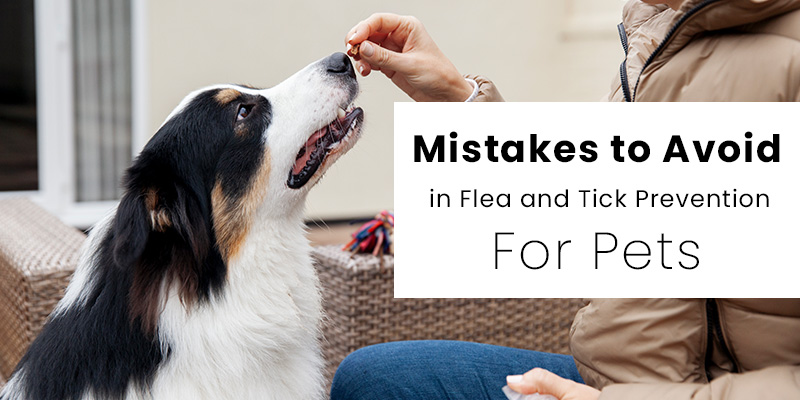Mistakes to Avoid in Flea and Tick Prevention for Pets

As responsible pet parents, it is our duty to protect our beloved furry companions from the harmful effects of fleas and ticks. These tiny parasites not only cause discomfort to our pets but can also transmit diseases that pose serious health risks. Unfortunately, many pet parents unintentionally make common mistakes when it comes to flea and tick prevention, unknowingly putting their pets in harm’s way.
Fleas and ticks are more than just a nuisance. They can cause itching, skin irritations, and even lead to more severe conditions such as anemia or tick-borne illnesses. However, by understanding the common mistakes in flea and tick prevention, we can take proactive measures to protect our pets effectively.
Throughout this blog, we will delve into each mistake, providing practical tips and guidance on how to steer clear of them. By doing so, we can ensure that our pets receive the best possible care and remain free from the discomfort and health risks associated with fleas and ticks. From misconceptions about seasonal breaks in treatment to the dangers of mixing different prevention products, we will address a range of common mistakes that pet parents often make. By learning from these pitfalls, we can establish a solid foundation for effective flea and tick prevention strategies.
Why Flea and Tick Prevention Should Be Year-Round
One of the most common misconceptions is that fleas and ticks are only active during the warmer months. While it is true that these parasites are more prevalent in spring and summer, they can still survive in colder climates. Fleas can thrive indoors, and ticks can remain active even in freezing temperatures. Therefore, it is essential to continue flea and tick prevention treatments throughout the year to ensure your pet’s safety.
Avoiding Missed Doses in Flea and Tick Prevention
Consistency is key when it comes to flea and tick prevention. Missing a single dose or skipping treatments can leave your pet vulnerable to infestations. Fleas and ticks reproduce rapidly, and even a brief interruption in treatment can lead to a full-blown infestation. It is crucial to follow the recommended dosage and schedule provided by your veterinarian to maintain the effectiveness of the preventive treatment.
The Risks and Dangers in Mixing Flea and Tick Prevention
Mixing different flea and tick prevention products without consulting a veterinarian can be dangerous for your pet. Some treatments may contain similar active ingredients, and combining them can lead to an overdose, causing adverse reactions or even toxicity. Always consult your veterinarian before using multiple products simultaneously to ensure the safety and effectiveness of the treatment.
Understanding the Differences Between Dog and Cat Treatments
Cats and dogs have different physiological and metabolic systems, making it essential to use species-specific flea and tick prevention products. Certain ingredients that are safe for dogs can be toxic to cats. Always read the labels carefully and consult your veterinarian to determine the appropriate treatment for each pet. Using dog-specific products on cats can lead to severe health complications and even be fatal.
Importance of Accurate Dosing in Flea and Tick Prevention
Guessing the dosage of flea and tick prevention products can be risky. Each product has specific guidelines for dosage based on the weight and size of your pet. Overdosing can lead to adverse reactions, while under dosing may render the treatment ineffective. Always use the dosage guidelines provided with the product or consult your veterinarian for accurate dosing instructions.
Myth about Flea and Tick Prevention for Indoor Pets
While it is true that indoor pets have a lower risk of exposure to fleas and ticks, it does not mean they are entirely safe. Fleas can hitch a ride indoors on clothing or other pets, and ticks can enter your home through open doors or windows. Additionally, fleas can lay eggs in carpets, furniture, or bedding, leading to infestations. Regular preventive treatments are necessary for both indoor and outdoor pets to ensure their protection.
[Also Read] Top 10 Ways To Prevent Fleas and Ticks on Dogs
The Role of Flea and Tick Prevention in Pet Health
Vaccines play a crucial role in protecting pets from various diseases, but they do not provide complete protection against fleas and ticks. Vaccines are designed to stimulate the immune system to fight off specific infections, while flea and tick prevention products directly target these parasites. Combining vaccines with preventive treatments is the most effective way to safeguard your pet’s overall health.
Bottom Line
Flea and tick prevention is an essential aspect of responsible pet parenting. By avoiding common mistakes such as assuming winter breaks, missing doses, mixing treatments, using the wrong products, eyeballing dosages, neglecting indoor pets, or relying solely on vaccines, you can ensure the well-being of your furry companions. Remember to consult your veterinarian for guidance on the most suitable preventive treatments for your pets. By staying vigilant and consistent, you can protect your pets from the discomfort and health risks associated with fleas and ticks year-round.

David joined CanadaVetCare in 2013 as a product analyst and veterinary assistant. Being a passionate pet lover and keen animal health researcher, David had always found ways and solutions to help pet parents to improve their pets’ health. He is always happy to answer pet health-related queries and recommending pet parents for the right pet product for their furry companions.

